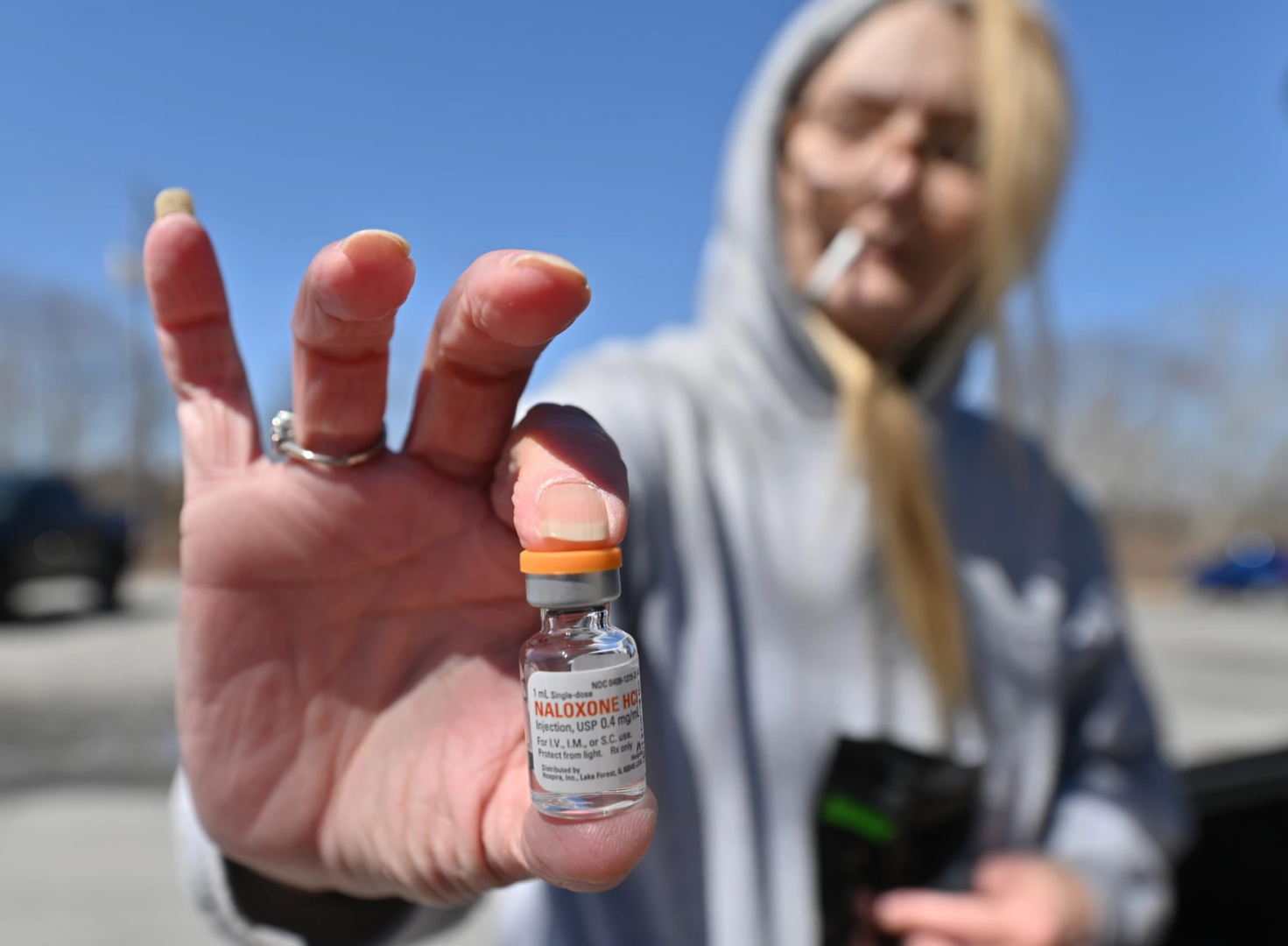
Pam Keefe holds a vial of naloxone, one of several supplies she distributes in her harm reduction work. In addition to the intramuscular version of the medication (pictured), she also stocks the nasal spray, Narcan.
Amiee Dilger

Pam Keefe holds a vial of naloxone, one of several supplies she distributes in her harm reduction work. In addition to the intramuscular version of the medication (pictured), she also stocks the nasal spray, Narcan.
Amiee Dilger

Amiee Dilger
Pam Keefe holds a vial of naloxone, one of several supplies she distributes in her harm reduction work. In addition to the intramuscular version of the medication (pictured), she also stocks the nasal spray, Narcan.
Pam Keefe’s youngest daughter, Michalene, did not have an easy childhood.
“She had a lot of trauma, a real lot… and her coping skills was drugs,” Keefe said.
Keefe is behind a nonprofit organization called Prevention Point NEPA – Michalene’s Mission. She’s pushing the boundaries of accepted harm reduction measures, because she wants to see addiction treated differently in Pennsylvania.
On a drive through downtown Wilkes-Barre, Keefe explained how hard it is to see someone struggle with addiction. She was against Michalene using methadone, a medication used to get people off the opioid street supply and ultimately treat opioid use disorder.
“I was terrible. I really was awful, because I didn’t know much about it until after – until it was way too late,” Keefe said.
This July marks five years since Michalene, 22, died due to an opioid overdose. A butterfly tattoo marking the date is visible on Keefe’s forearm.
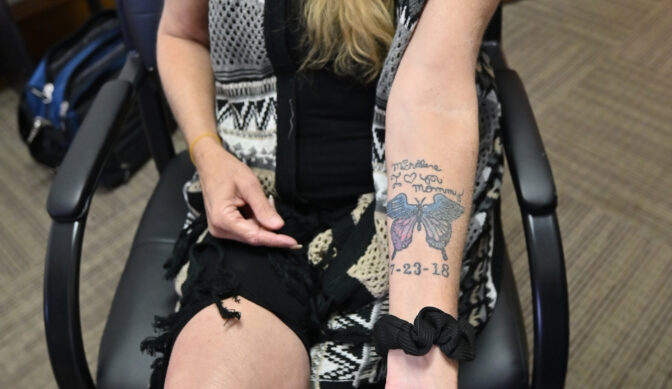
Amiee Dilger
Pam Keefe shows the tattoo that honors her daughter, Michalene, who died due to a drug overdose.
Keefe admits her mindset about addiction and drug treatment completely changed after her daughter’s death. Since then, she has met many people who cope with trauma by using drugs. It’s her experience that tough love doesn’t work, and neither does forcing someone with an addiction to enter a treatment program. In other words, simply keeping them alive is the goal. According to state statistics, overdose deaths in Pennsylvania more than doubled between 2012 and 2022 with over 5,000 lives lost last year.
“From what I see, their self-worth is gone, their self-esteem is gone. They don’t need somebody else judging them… they need some caring and compassionate individuals,” she said, adding that an empathetic approach allows people to open up and possibly accept help.
Keefe is one of many advocates across the state that want more tools to combat the opioid epidemic. They say state law ignores federal public health advice by banning access to clean syringe services. The history of harm reduction in Pennsylvania goes back decades, but controversy remains around the public health guidance.
Keefe told WVIA News she distributes naloxone, the medication that reverses opioid overdoses, and drug-testing strips, which lawmakers decriminalized last year. If asked, she checks drugs for fentanyl, a powerful synthetic opioid, and xylazine, an animal tranquilizer sometimes known simply as “tranq.” In addition, she treats the people’s wounds, helps them get into treatment and tests them for HIV and hepatitis C (work that supports the Wyoming Valley AIDS Council).
Most of her supplies come from NEXT Distro, a harm reduction organization based in New York, and the state’s naloxone program. In a partnership with NEXT, the state has sent out more than 1.3 million doses of naloxone to organizations over the last six years, according to Gov. Josh Shapiro’s administration.
For now, Keefe mostly operates out of her car in Luzerne and Lackawanna counties, but she’d like to put down more permanent roots.
She applied for American Rescue Plan Act (ARPA) funds through Luzerne County for a brick-and-mortar location. While that request wasn’t funded, the county did put aside $50,000 for her mobile nonprofit.
But that money can’t be spent on everything that harm reduction supporters want in Pennsylvania.
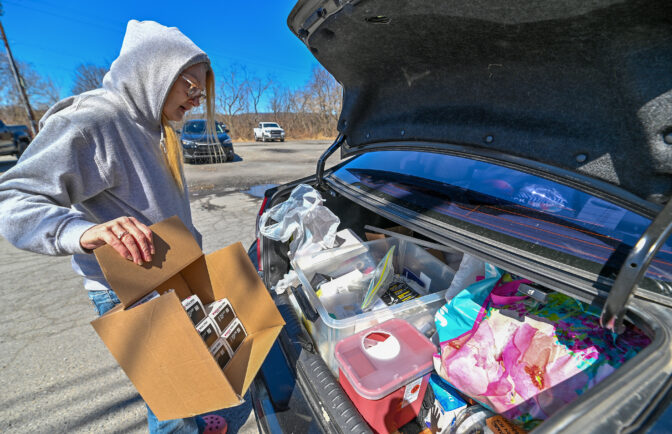
Amiee Dilger
Keefe operates a harm reduction nonprofit from her car and hopes one day for a permanent location. She tests people for HIV and Hepatitis C and keeps supplies like naloxone, condoms and toiletries on hand.
Public health perspectives and state laws diverge
When Keefe makes her rounds in the community, she safely disposes of used needles and sometimes exchanges them for sterile ones. The practice, known in the public health world as a syringe services program (SSP), typically offers clean needles, connections to treatment and disease testing.
Last year, the White House included SSPs in its strategy to combat the nation’s drug crisis. Most states permit syringe programs and some, like New Jersey, put money toward them.
The Centers for Disease Control and Prevention found that people are five times more likely to begin drug treatment and three times more likely to stop using drugs altogether if they have access to a syringe program.
And the Pennsylvania Department of Health favors SSPs as a harm reduction tool. But the state itself doesn’t operate such a program because a drug law in the commonwealth labels syringes as paraphernalia. That keeps money from federal programs out of the hands of harm reductionists in Pennsylvania.
That still hasn’t stopped advocates from running SSPs while pushing for changes in state laws. Except for authorization in its largest cities, Pennsylvania remains one of just a handful of states that doesn’t explicitly allow needle exchange programs.
Exceptions for SSPs in Pa.
Prevention Point Pittsburgh and Prevention Point Philly – groups that share a name but operate independently – first started underground SSPs as HIV/AIDS prevention organizations in the 1990s. Though Keefe named her organization Prevention Point NEPA, her group is also independent.
Harm reductionists said their work reduced blood-borne disease transmission and even got people clean. Local leaders eventually got on board. Ordinances passed in Philadelphia in 1992 and in Pittsburgh in 2001 have allowed the organizations to openly operate syringe programs while providing health screenings and case management services.
A 2019 George Washington University study found that Prevention Point Philly prevented more than 10,000 HIV cases over ten years through their clean needle program. But efforts to make SSPs available statewide have never made it through the legislature.
Olivia Oden works with the Susquehanna Valley United Way, which covers Columbia, Montour, Northumberland, Snyder, Union and lower Luzerne counties. She’s director of a program called United in Recovery that focuses on behavioral health and substance use disorder. Separate from her full-time job, Oden does community outreach with Keefe.
“We’re hit too in the rural areas, and I feel like across the state folks lose sight of that because… when we think of syringe exchange, we think of Pittsburgh and Philadelphia,” said Oden, who is in recovery herself. “But what about us up here? We have the archaic laws, we have the policy that hasn’t budged since the 80s. People are dying and things need to change.”
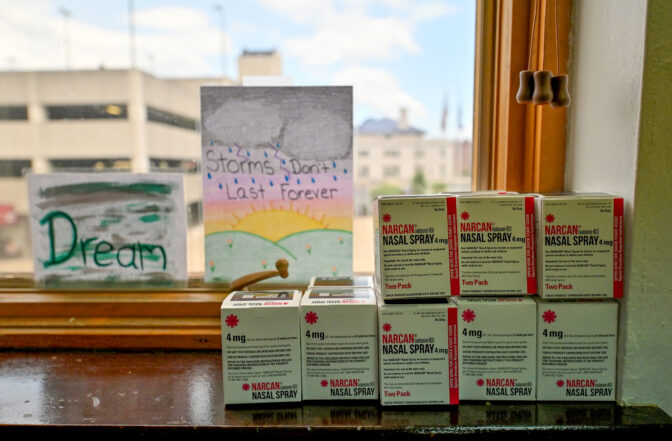
Amiee Dilger
Boxes of Narcan, a brand of nasal spray naloxone, sit on a windowsill. The medication reverses an opioid overdose.
Understanding the controversy
Opponents of syringe services programs – not to be confused with supervised consumption sites, a topic of recent state controversy – say they enable drug use instead of taking a punitive approach. Others are concerned, if not collected properly, more needles could be discarded in the streets.
In states like Indiana, which authorized syringe programs after a surge in HIV cases in 2015, local leaders pushed back years later, voting to end the service. Commissioners in Indiana’s Scott County said they didn’t want to contribute to drug use, despite the protests of health officials to keep syringe programs running.
“I know people that are alcoholics, and I don’t buy him a bottle of whiskey, and … I have a hard time handing a needle to somebody that I know they’re going to hurt theirself with,” said Scott County Commissioner Mike Jones, in a story reported by NPR.
But supporters say, without these programs, less people will find their way out of life-consuming addictions.
Amy Ronshausen is the executive director at the Drug Free America Foundation. The Florida-based national organization promotes drug prevention legislation and opposes policies like recreational marijuana legalization. She said it might surprise some people that they believe in harm reduction practices.
“For some reason harm reduction is a scary term or controversial term to some,” Ronshausen said. “Harm reduction is a bridge. We didn’t catch everybody with a prevention message. There’s people out there living in active addiction with a substance use disorder. They might not be ready to take that next step.”
More support for harm reduction laws has come with more evidence, and groups like Drug Free America might not have been on board 15 years ago, Ronshausen said. In 2019, Florida allowed counties to decide for themselves whether or not to allow syringe programs.
“But as these things are established and developed and studied, as long as we’re putting more people into treatment and into recovery, that’s what matters,” Ronshausen said. She added that a “gold standard approach” for syringe programs would also offer people drug treatment under one roof.
She said if someone’s family hasn’t been impacted by addiction, they may still be hesitant about harm reduction policies or public health measures.
“They don’t understand that addiction is a chronic relapsing disease and so sometimes they have this thought process of ‘why can’t they just quit using?’” said Ronshausen, whose cousin died of a heroin overdose four and a half years ago. “You don’t want to wait until this is a tragedy that’s on your own doorstep,” she said.
Pa. Rep. Jim Struzzi (R., Indiana) said, although a drug overdose took his brother’s life at age 31, he was still skeptical about syringe exchange programs.
To advocates and recovery specialists, “it seems simple,” Struzzi said. “But for others it can be very complicated.” He visited Prevention Point Pittsburgh and saw how the team operated. He said the experience was eye-opening.
“It wasn’t just randomly handing out needles,” he said. “It was an actual program that was invested in trying to get people help.”
In June, Struzzi reintroduced legislation that would legalize SSPs statewide in Pennsylvania. The opioid crisis has affected his co-sponsors, too. Former Rep. Sara Innamorato (D., Allegheny) lost her father to an opioid addiction in 2009.
Convincing the public and other lawmakers could take time. Struzzi, who previously pushed for the legalization of drug-testing kits, said it took three years for that bill to amend a state paraphernalia law.
Addressing stigma
Along with advocates, first responders have been on the front lines of the opioid crisis.
In a study published last year, researchers at Penn State asked police officers and students in EMT and paramedic programs about their feelings toward reversing opioid overdoses with naloxone.
They surveyed 282 participants in the U.S. Northeast and overall found “slightly negative attitudes” about harm reduction strategies. As a result, the researchers suggested teaching first responders about addiction as a disease could reduce the stigma about the life-saving medication.
Regardless of their views, first responders took an oath to assist anyone who calls for help, said David Prohaska, spokesman and paramedic with Trans-Med Ambulance. The company responds to dispatch calls around Luzerne, Edwardsville and Wilkes-Barre Township.
“A lot of people have opinions about what’s wrong with the system or how they’re trying to fix this epidemic problem, but it doesn’t stop anyone from responding and treating the proper way,” Prohaska said. Though, responding to the same houses multiple times and reviving the same people with naloxone weighs on some paramedics over time, he said, and that affects their views on harm reduction.
Representatives from the Wilkes University Pharmacy Practice focused on the science when speaking with paramedics in Wilkes-Barre earlier this year. They taught EMTs and firefighters the facts and myths of fentanyl exposure and how addiction impacts the brain. Presenters also touched on harm reduction.
“Everybody should have fentanyl testing strips. Everybody should have naloxone as a safety precaution,” said Wilkes Associate Professor Dr. Tom Franko. “No different than saying make sure your oil is changed and wear a seatbelt, or make sure you have a fire extinguisher in your home. Because you don’t intend to light your kitchen on fire, but you’re happy you have this thing in case, God forbid, you do.”
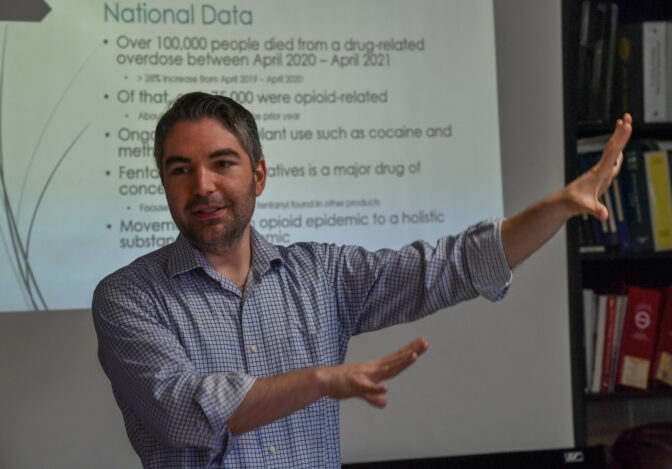
Amiee Dilger
Dr. Thomas Franko, Wilkes University Associate Professor of Pharmacy Practice, speaks to first responders about fentanyl and the opioid epidemic in Wilkes-Barre on April 14.
Franko also encouraged EMTs to challenge the way they think about responding to drug overdoses.
“You could be the person that helps, and it might be that third, fourth, 20th time you’re going and visiting that same person. But maybe that’s the time that that person now has the courage – and that’s really what it is, courage – to go and get help,” he said. “That’s a mom or a dad or a son or a daughter that’s alive today because of you.”
During the training session, a dispatch call came in: “… 19-year-old male patient unresponsive…”
A few EMTs stood up and made their way to an ambulance. “There’s your overdose,” one said.
After they returned to the station, EMTs confirmed what they suspected – they revived someone with naloxone. Wilkes-Barre Fire Chief Jay Delaney said the department used nearly 200 doses of naloxone last year, down from more than 400 doses in 2017.
“What’s the difference [between] saving a life from a fire versus the 15-year-old that overdosed on fentanyl?” Delaney said before the Wilkes team’s presentation. Without the naloxone EMTs administered last year, he asked, “Where would we be today?”
Civil disobedience
Advocates in northeastern and central Pennsylvania are not alone. Pam Keefe has pointed to mobile harm reduction programs in York, Lancaster and Harrisburg that say it’s not worth waiting for laws to change around syringe programs to follow national and state public health recommendations.
In Cambria County, Rosalie Danchanko feels the same. She’s executive director at Highlands Health in Johnstown. Around 2016, her organization and a regional hospital were called upon to brainstorm remedies for the opioid crisis, she said. That hospital backed out when talk of a syringe program came up.
But Danchanko was ready to act. She recently lost a niece to an overdose.
“We’re not not bashful about doing whatever is needed to help save lives,” She said. “So at that point, we went underground.”
Highlands started providing clean needles to people with chronic diseases like diabetes, but also to people who use drugs, she said. Though the medical clinic started the program covertly, Danchanko said the county sheriff’s office took note.
“I got pushback to the point where I was threatened with jail,” she said. But the health center in Johnstown has continued operating for years without interference. Because she runs a full medical clinic, Danchanko said she’s not worried about repercussions. She sees her work as civil disobedience.
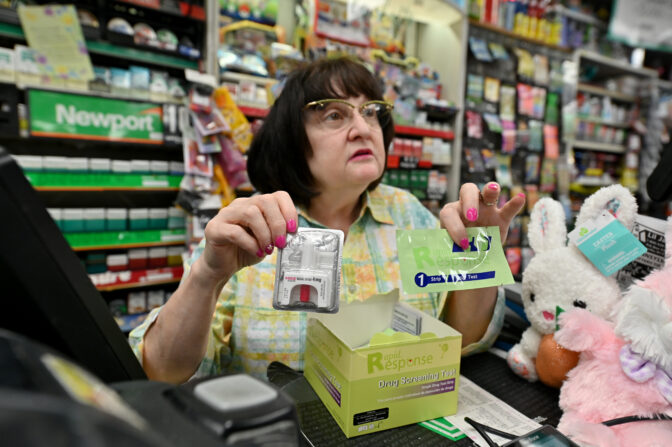
Amiee Dilger
Ann Marie Bossard, co-owner of Anthracite Newsstand, holds up nasal spray Narcan and a drug screening kit for fentanyl. Pam Keefe visits businesses and asks if they’ll stock the harm reduction supplies.
Harm reduction in the community
Back in Wilkes-Barre, Keefe told WVIA she used naloxone while doing outreach at a homeless encampment. She also had to use it at home.
“Twice under the bridge, I walked into it,” Keefe said, “and then twice with a family member… all four times CPR was administered. It’s kind of scary, it’s not pleasant to see.”
She trains people how to use Narcan, a brand of nasal-spray naloxone. She keeps the injectable form of the medication on hand in case the person who’s overdosing can’t be rolled onto their back.
When WVIA News followed Keefe this spring, she carried fentanyl testing strips and offered to test drugs for a young woman who requested harm reduction supplies and toiletries. Keefe also wanted to see how she was doing.
To protect the woman’s identity, WVIA is not publishing her name. She hadn’t had stable housing for close to two years and was staying at someone’s house temporarily. The drug residue that Keefe tested in a small amount of water came back positive for fentanyl. The tests can only tell if fentanyl is present in a sample – not how much fentanyl there is.
The woman wasn’t surprised that the substance contained the strong opioid. Keefe reminded her to never use alone in case of an accidental overdose.
That sort of information is valuable to people who don’t expect to find an opioid in drugs like methamphetamine, cocaine or crack. It could save them from overdosing, as even tiny amounts of fentanyl can slow or stop someone’s breathing if they don’t have an opioid tolerance.
Keefe can also test for xylazine, which is sometimes mixed with fentanyl and is known to cause serious skin sores. She has found the drug combination on toxicology reports from Luzerne County. So far in 2023, at least 64 people have died from drug overdoses in Luzerne, according to the county coroner’s office. Ten other possible overdose deaths were pending a review in early July.
In April, Keefe stopped by the St. Vincent de Paul Kitchen in downtown Wilkes-Barre. Outside, a man named Ed gave her a hug. Keefe had given him two doses of Narcan about a month earlier. WVIA is not using his last name due to the nature of his story.
He’d been sober for three years after using heroin and methamphetamines for 35 years, he said in an interview with WVIA News.
But this spring Ed relapsed. He injected what he thought was heroin and overdosed. Someone checked his backpack and found the Narcan from Keefe. They sprayed the medication into his nose and he regained consciousness.
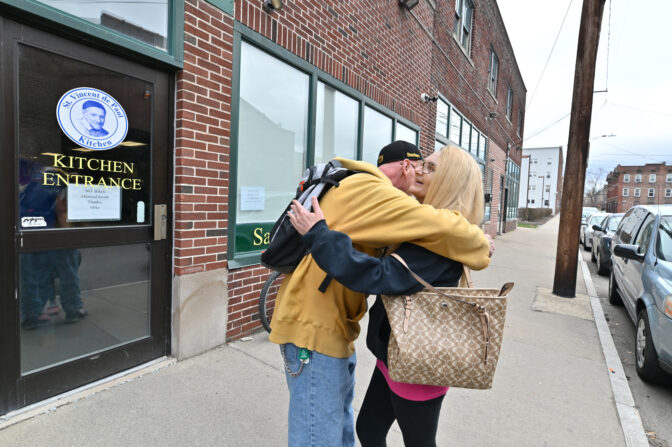
Amiee Dilger
Ed hugs Pam Keefe outside the St. Vincent de Paul Kitchen in early April. Keefe gave him naloxone earlier this year. When he overdosed, someone used the medication to revive him.
Ed said he spent a month at a rehab facility and now has a prescription to manage his addiction. It was the first time he’d seen Keefe since the ordeal.
“I thought I’d be using [the Narcan] on someone else,” he said. “She’s a lifesaver.”
Advocates hope their efforts reach more people like Ed and inspire them to seek treatment. Keefe said she’ll continue her harm reduction work despite roadblocks in state drug policy. Stories like Ed’s show her that she’s making an impact.

A collection of interviews, photos, and music videos, featuring local musicians who have stopped by the WITF performance studio to share a little discussion and sound. Produced by WITF’s Joe Ulrich.
The days of journalism’s one-way street of simply producing stories for the public have long been over. Now, it’s time to find better ways to interact with you and ensure we meet your high standards of what a credible media organization should be.